We just went through my office over the last month and cleaned out a lot of our old files of maps, saving only what really mattered.
For a handful of projects, I saved preliminary versions of the routings that were different from the final plan. But, after seeing Alex's post, perhaps I should destroy all of those, so that eighty years from now people aren't second-guessing whether I made the right choice!
Geoff S's explanation of the MacKenzie plan for #16 is probably the correct one -- he wasn't sure yet whether he would build the back tee on #16. However, I suspect his hesitation was more about whether it would work as a par-4, than as a par-3. It would be a pretty long forced carry from the proposed par-4 tee just to get onto the fairway!
It's also strange to note that there isn't actually a tee drawn at the spot where the centerline for #16 starts.
Tom, I wouldn't publicize your spring cleaning or you might find some of these guys digging through your garbage cans like rabid raccoons.
For me the changes between the various plans and the final are interesting not so much for second guessing MacKenzie (although that is fun too) but rather for trying to figure out the genesis of the design, including what if any influence Raynor's ideas might have had over the final routing. Arguably the changes noted by Alex indicate that whatever the original source of the routing, there were substantial changes made between this routing and the final one, and MacKenzie is the most likely source of these changes. In other words, even if early maps plans were largely influenced by Raynor's ideas, the significant changes must have been AM's.
(Alternately, I suppose one could argue that AM did his own original routing, the one shown on this early rendering, and then over time he had to scrap various aspects of his routing (like the par 3 sixth, for example) and move back in time to whatever Raynor had originally come up with, but this seems strikes me as counter-intuitive and unlikely.)
As for CPC 16 as a Par 4, here is approximation based on MacKenzie's February 1926 plan, displayed on the inside cover of Geoff's book. The long carry (red line) is marked as 214 yards. The shorter carry from the alternate tee (orange line) is marked as 143 yards, and the white line is 207 yards.

So the hole in this version would have been something like a cape hole requiring a significant carry from the tee (the shortest carry to there present fairway on a line between the red and white line would have been about 170 yds.) I assume that the area below the orange line would have been in play, so the golfer from the back tee (or the alternate tee) could have chosen to cut off much less.